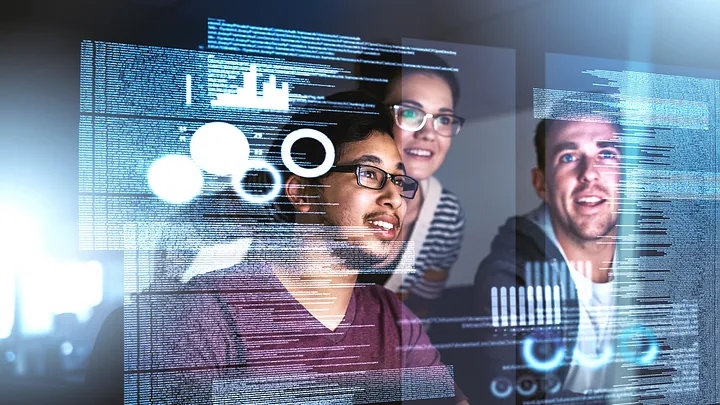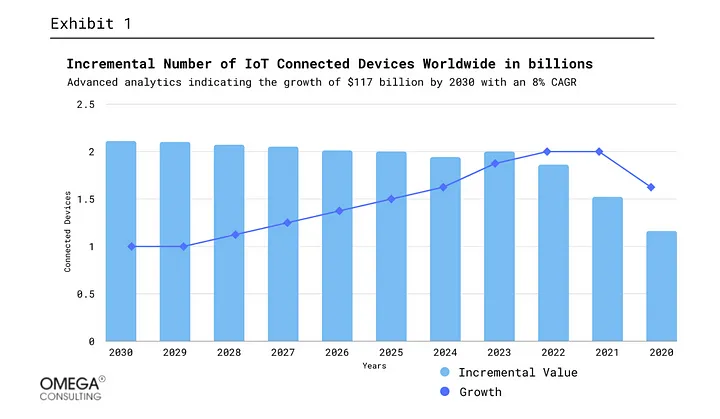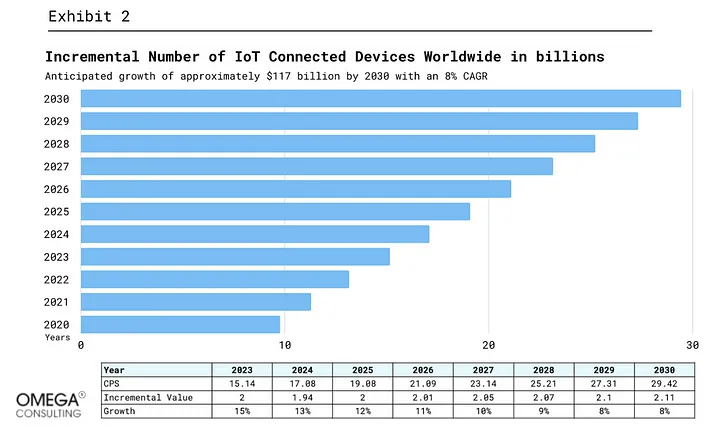- Industries
Industries
- Functions
Functions
- Insights
Insights
- Careers
Careers
- About Us
- Technology
- By Omega Team

Cyber-Physical Systems (CPS) are systems that integrate real world hardware, digital software, and networking elements to monitor and manage physical processes. To accomplish a certain objective, such as managing a production process or maximizing energy usage, they are made to cooperate with one another and interact with their surroundings. Healthcare, transportation, security, and autonomous decision-making are just a few examples of the many uses of cyber-physical systems. A “physical entity” and its “cyber-twin” are coupled in a Holonic system known as a “cyber-physical system.” This “cyber-twin” is essentially a “computational relational model” of the physical entity, enabling it to virtually mimic the machine’s behavior and provide insight into how the machine would respond when given different commands with the help of sensors and actuators.
A definition given by Shankar Sastry from the University of California, Berkeley in 2008: “A cyber-physical system (CPS) integrates computing, communication and storage capabilities with monitoring and/or control of entities in the physical world, and must do so dependably, safety, securely, efficiently and in real-time”. The worldwide cyber-physical systems (CPS) market was around $76.98 billion in 2021, and it is anticipated to grow to approximately $117.57 billion by 2030, with a roughly CAGR of roughly 8.01% between 2022 and 2030.

The phrase “CPS” is occasionally mistaken for “cybersecurity,” which refers to the confidentiality, integrity, and availability of data but has nothing to do with actual physical processes. Therefore, the word “cybersecurity” refers to the safety of cyberspace and is only tangentially related to cybernetics.
Advantages of Cyber-Physical Systems
Integration of Cloud and Wireless Sensor Networks is a critical component of CyberPhysical Systems. CPS provides network integration characteristics such as media access control techniques and their effects on system dynamics, middleware, and software, that provides network coordination, network transaction timing control, and fault tolerances. CPS will improve response time, allow for early failure detection, and proper resource utilization such as bandwidth. CPS, as a component of cloud computing, can also provide users with resources based on their requirements.
Difference between Cyber-physical Systems and IoT
The Cyber-Physical System and Internet of Things (IoT) concepts emerged from various groups, with CPS originating primarily from a systems engineering and control standpoint. A cyber-physical system is used to control physical phenomena by sensor networking and embedded computing. When software components are used to connect mechanical and electrical systems in a network, they manage logistics and manufacturing systems autonomously using shared knowledge and data from processes.
The Internet of Things (IoT) concept, on the other hand, arose primarily from an information technology and networking standpoint, with the goal of fusing the digital and physical worlds. CPS has an embedded mechanism that supervises the surrounding or physical environment with the help of sensor networks and computing. Computer-based algorithms control and monitor the mechanism.

With human assistance, these systems can evaluate operational conditions autonomously and then support decision-making. Whereas IoT requires no human connection or intervention IoT.
Digital Twins and Cyber-Physical Systems
CPS is digitalized in a virtual clone, which creates a cyber and physical system entity from which many different outcomes can emerge, that might be a useful tool for system development, optimization, and monitoring. The presence of a virtual version of the full cyber-physical system opens the door to a variety of possible outcomes. The cyber-physical system must be capable of being virtualized in a condensed virtual environment in order to evaluate the physical environment in real-time, continually learn from it, and deliver accurate and trustworthy information about the actual scenario.
Through the twin, the system may analyze and forecast the behavior of the physical system while not jeopardizing its operation and designing solutions to deal with global dynamics. Furthermore, more than one twin can be created. that verifies any faults, malfunctions, or even digital threats.
CPS in Manufacturing
In the industrial sector, a cyber-physical system is a physical object that can connect to the internet, such as a pump or compressor, and is incorporated with computers and control elements like sensors and actuators. Such an IP-assigned entity is capable of self-monitoring, information generation on its own operation, and communication with other related entities or even the outside world. It is a self-governing, independent system.
As the Fourth Industrial Revolution develops over the coming years, industrial firms will increasingly rely on the principles of CPS to help them achieve operational excellence through increased productivity, effective use of all resources (both material and human), satisfied customers, and increased shareholder value. We saw the beginnings of the Industrial Internet of Things (IIoT), edge/cloud computing, artificial intelligence (AI), autonomous robotics, and other technologies. Manufacturing will change as a result of the combination of digital and industrial technologies, which will also contribute to the realization of the Industry 4.0 goal.
CPS in Industry 4.0
When cutting-edge technology is incorporated into physical frameworks, critical infrastructure may be affected more frequently. The application of CPS to promote sustainability is expanding. CPS aids firemen in spotting and averting fires in addition to boosting agricultural practices and helping scientists to minimize subsurface oil spills. System capabilities, adaptability, scalability, resilience, safety, security, and usability will increase greatly thanks to CPS developments compared to the present generation of simple embedded systems.
The expansion of the number of IoT-connected devices has changed and enhanced the role of CPS, enhancing productivity, efficiency, and financial advantages. Improvements in real-time processing, detection, and actuation between IoT systems and physical domains are also provided, as well as capabilities for system analysis of the related cybernetic and physical structures.
CPS in Medical
In the past, patients were treated without the use of the internet through standalone healthcare service delivery systems that were separately created, approved, and implemented. Distributed systems that were created to simultaneously monitor and regulate a number of the patient’s physiological features have been added by MCPS. It is a mix of networking capabilities, intricate physical dynamics, and embedded software controlling medical equipment that is employed in preventative, curative, palliative, and rehabilitative healthcare services. In addition, CPS’s use in medicine came to be known as MCPS.
Hospitals employ MCPS, or “critical integration of a network of medical devices,” to provide ongoing, high-quality treatment. The MCPS is, in other words, a “platform in which the patient health metrics are obtained by the use of emerging technologies and analyzed using powerful machine intelligence algorithms on the cloud.” The implementation of MCPS in hospitals leads to remote patient monitoring, control, medication development acceleration of therapy, and enhanced care standards.
CPS in Smart Cities
Smart cities are those that use technology to establish intelligent plans for inclusive growth, effective infrastructure for local communities, a clean and sustainable environment, and other resources to provide residents with a respectable standard of living. By combining cyber services with city health services, for example, digital technologies and their interactions with physical systems offer smart solutions that might spur economic growth by strengthening infrastructure and services, generating jobs, and increasing the quality of life in smart cities. Future cities will likely rely heavily on CPSs since many of these smart city applications rely on intelligent sensing and realtime monitoring, controls, data processing, and decision-making.
CPS in Transportation
Future smart cities are anticipated to see a paradigm change in a number of areas, including transportation. The design of the city’s transportation infrastructure has a significant impact on the growth of urban structures, functioning, and prosperity. With its ability to handle massive data integration, user driven solutions, real-time decision-making, and leveraging learning to create better adaptive solutions, artificial intelligence has the potential to revolutionize transportation systems throughout the world.
The “always connected” transportation paradigm is quickly becoming a reality, and the linked car is now a widely accepted fact. We are now searching for a city mobility ecosystem that guarantees there will be no traffic accidents, decreases emissions, and assures more predictable travel. Modern automobiles utilize green fuel, are safer, more sophisticated, and always connected. They are also more autonomous than ever. Today’s roadways are more than just a physical structure; they are “empowered” with info communications, intelligence, and sensing capabilities and are able to collect tolls, harvest energy, and weigh moving automobiles, among other things.
Therefore, the connected mobility system was created to handle traffic jams and environmental degradation as well as to provide better, faster, cleaner, and less expensive rail, road, and air transportation services by utilizing the advancements in communications networks, IoT, cloud, and edge computing, scalable storage, and data empowered insights can be referred to as the Transport Cyber-Physical System (TCPS). It is the next shared, autonomous, linked, and data driven transportation paradigm for urban environments of the future.
Conclusion
Cyber-Physical Systems alter how humans interact with the physical and computer worlds. It is expected that cyber-physical systems will play a significant role in the design and development of future engineering systems with capabilities that far outperform today’s levels of autonomy, functionality, usability, dependability, and cyber security. Close collaborations across academic disciplines in computing, communication, control, and other engineering and computer science fields, as well as grand challenge applications, can accelerate CPS research advances.
Many new control systems and software and internet address are connected through the internet of things, These are the same functionalities, such as track, trace, and remote monitoring, that we are using in the Industrial IoT for the development of the smart factory as well as the current trend of automation and data exchange in industrial technologies, including CPS, IoT, cloud computing, and cognitive computing. For the development of several cutting edge CPS applications, a well designed communication network with dependable quality of service assurances is a crucial foundation.
For access to the PDF Version, please email info@omegaconsultingonline.com.
Subscribe
Select topics and stay current with our latest insights
- Functions